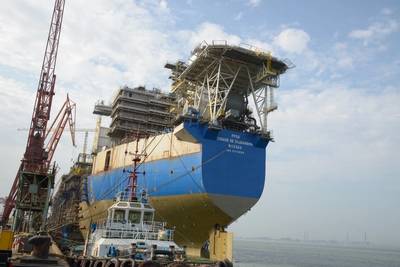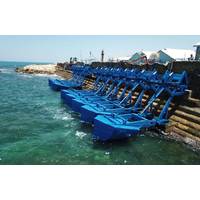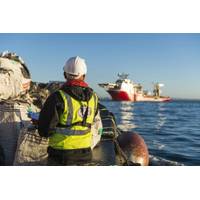Finding stability in choppy waters: case study by ING, $1.55 billion financing of the Cidade de Saquarema FPSO
The $1.55 billion financing of the Cidade de Saquarema floating production, storage and offtake (FPSO) vessel had a difficult genesis and complex logistics.
SBM Offshore and its co-sponsors overcame these challenges to achieve cost effective financing with the world’s first FPSO deal backed by four export credit agencies. ING contributed to the success of this financing in its capacity as global coordinator, joint swap arranger, documentation agent, joint bookrunner and facility agent.
SBM Offshore is a leader in floating production, storage and offtake (FPSO) vessels and pioneered the financing of these offshore oil facilities by commercial banks in the late 1990s.
A recent transaction, the $1.55 billion financing of the Cidade de Saquarema FPSO, which will be used in the Lula field off the coast of Brazil, again broke new ground: it was the largest project financing in the company’s history and the world’s first to utilize the support of four export credit agencies (ECAs) in a single transaction.
“Our success in establishing the benchmark for commercial bank FPSO financing, in terms of documentation and what constituted a successful deal, meant that while some of our competitors turned to the ECA market we were a late starter because we didn’t immediately see the benefits,” explains Herve Lalli, former finance director and now commercial director of SBM Offshore. “But when we began to consider how we would finance Cidade de Saquarema and its sister vessel Cidade de Maricá we decided that one of our principal objectives was to diversify our sources of funding.”
SBM Offshore realized that the involvement of Mitsubishi and
Nippon Yusen Kabushiki Kaisha (NYUKF) (NYK) as Saquarema’s sponsors (along with SBM Offshore and Brazilian company Queiroz Galvão Óleo e Gás) enabled it to approach Nippon Export and Investment Insurance (NEXI), the Japanese ECA. NEXI is known to favor deals that also involve ECAs from other countries, so SBM Offshore therefore planned to bring more ECAs into the deal. “In particular, we saw that it would be important for the Netherlands’ Atradius to be involved,” says Lalli.
Having decided to pursue an ECA-backed transaction, SBM Offshore approached the deal with typical vigour and also sought to bring Servizi Assicurativi del Commercio Estero of Italy and UK Export Finance into the deal in order to optimize the use of ECA cover and ensure the financing was as efficient as possible.
Change of plans
Originally the sponsors’ intention was to finance both Saquarema and Maricá through a single transaction involving ECAs. However, because of compliance problems at SBM Offshore this proved impossible to achieve in a timely manner. “In May 2014, we realized that there was a risk that the financing for Saquarema and Maricá would be delayed.
We therefore decided to split the deals and finance Maricá on a commercial basis,” recalls Lalli. “The bank market was bullish at the time and we were able to wrap it up in just two and a half months.” Maricá was financed by a $1.45 billion limited recourse facility in July 2014, with ING acting as facility agent, account bank and security trustee.
In the second half of 2014, the deterioration of Brazil’s economy and the challenges facing Petrobras affected the creditworthiness of the transaction. “Given the circumstances, it was a relief that Maricá had been completed and also that we’d chosen to engage with ECAs. By that time it would have been difficult to complete a commercial transaction for Saquarema but we knew that with the support of the ECAs and that the transaction would be achievable and attractive to investors – we just had to work hard to make sure all the parties involved get something they were happy with.”
The deal’s attractiveness to commercial banks was bolstered by the decision by Atradius to maintain the same level of support for Saquarema that it had originally planned for both Maricá and Saquarema, boosting the proportion of ECA cover for the deal to $1.2 billion. However, the transaction remained far from straightforward given the unpromising backdrop of a falling oil price and SBM Offshore’s ongoing compliance challenges.
Moreover, the financing process also faced some challenges “Initially, a number of banks were involved in the structuring of the financing and in ECA discussions, but they did not provide the efficient progress that the sponsors wanted.” says Lalli. “When ING was mandated as global coordinator, they took over leadership of the banks and there was an immediate improvement in the way the transaction was managed.”
Taking control
SBM Offshore’s relationship with ING goes back over 20 years: the bank began by providing the company with straightforward banking services and has since developed a broader relationship that encompasses lending, financial markets (including derivatives), corporate finance, equity capital markets, and payments and cash management. Of course, it was with ING that SBM
Offshore developed the template for financing FPSOs in the commercial bank market in the late 1990s.
As well as being a longstanding client, ING’s relationship with SBM Offshore is important because of the company’s approach to sustainability. “ING has a framework for assessing the sustainability of its clients, one parameter of which is an external review by the sustainability research company Sustainalytics,” notes Erwin Nederkoorn, global head of
offshore oil and gas services in structured finance at ING. “Compared to its peers, SBM has a sustainable approach to business.”
For Lalli, ING’s involvement in financing Saquarema was essential, especially given that it was working with so many new advisors. “While previous FPSO financings were completed with the same team of technical and insurance advisors, the ECAs wanted to appoint some different advisors,” he says. “Fortunately, we had ING on board to provide continuity. We trust each other and know we can rely on each other. ING challenges our assumptions about a deal – but in a way that benefits the transaction. We know that once we’ve made an agreement with ING they will manage – and convince when necessary – the other banks. Some global coordinators agree one thing with us and then come back saying they’ve had push-back from other banks: that never happens with ING because they are tough and respected.”
Complex logistics
One major challenge for ING was the large number of ECAs involved in the deal, which made the logistics of the Saquarema deal extremely complex. “There had never been an FPSO deal with four ECAs before and this transaction also involved multiple sponsors, each of which had different perceptions of risk and views on the sector, and different internal processes and resources,” says Jacco Bakker, vice president offshore oil and gas services in structured finance at ING. “Keeping every party on the same page was key to the success of this project,” agrees Naoki Arima, team leader, FPSO business team, engineering business department at Mitsubishi Corporation.
To overcome these challenges, ING communicated intensively with all parties on a regular basis and also held three two-day meetings in Amsterdam with the sponsors, ECAs and banks – 25 people in total – discussing every aspect of the deal on a step-by-step basis to ensure everyone’s views were taken into account.
“Throughout the process, ING was in the middle balancing the needs and expectations of the various parties,” says Bakker. “To structure a multi-sponsor, multi-ECA deal trust is essential. Because all the parties involved recognise the depth of our expertise, they could place their trust in us. Our relationship with SBM and Mitsubishi meant that they could be certain we understood the commercial requirements of the project fully while our experience of working with ECAs gave them comfort that we understood the importance of credit risk to them and the need for any transaction that they work on to reflect positively on their government and country.”
ING has a global network of 25 structured finance specialists in all cities where major ECAs are based, including Frankfurt, London, Paris, Amsterdam, Prague, Warsaw, Tokyo, Seoul and New York. “Our proximity to ECAs helps with language and relationship building, which are critical to ECA financing because of its complexity: you need to know ECAs and their approach and strategies well if you are to achieve your clients’ goals,” says Nederkoorn. “Based on our relationships and our track record across multiple sectors, ING knows how each ECA looks at deals from a structuring perspective, what their content requirements are, and what businesses they aim to support.”
Mitsubishi’s Arima confirms that the role played by ING as an impartial mediator was crucial: “We faced deadlock-like situations a few times around the negotiating table with the ECAs but ING managed to facilitate discussions among the parties every time,” he says. “When we faced a difficult situation, ING communicated with the ECAs and banks and found constructive solutions to move the deal forward.” Nederkoorn adds: “Ultimately, the transaction required creativity, the ability to build trust and an optimistic pragmatism that always saw us looking for the highest quality compromise possible.”
Delivering results
For SBM Offshore and the other sponsors, the $1.55 billion Saquarema financing, which closed in July 2015 after one-and-a-half years of work, achieved all of their objectives. Of the total deal, $1.2 billion received ECA cover, enabling SBM Offshore to close its largest project financing to date. A total of 16 commercial banks joined the facility, with a final oversubscription of almost 200% indicating the level of enthusiasm for the structure.
“There is a premium to be paid for insuring a deal via ECAs but overall we were able to achieve a longer tenor and higher leverage for Saquarema than for Maricá so it was a premium worth paying,” says Lalli. “And while the cost of finance for the uncovered tranche of the Saquarema deal was in line with that of Maricá that was only because the small size of the commercial tranche meant we could be aggressive. If the entire deal had been commercial, pricing would have been higher. “
While Lalli is modest enough to point out that SBM Offshore is a follower rather than a leader in ECA-backed FPSO financing, Saquarema did set a precedent as the first transaction to involve multiple ECAs. “Furthermore, we managed to largely impose our way of doing transactions on the ECAs – the Saquarema documentation is largely the same as that used for Maricá – so in that sense we did achieve a first for the market. What was most important, however, is that Saquarema was cost effectively financed at a time when the industry – and SBM Offshore – faced many challenges and that we now have an additional financing option available to us in the future.”
Note: This content is provided by OGF Global for informational purposes only, and it reflects the market and industry conditions and presenter’s opinions and affiliations available at the time of the presentation.












